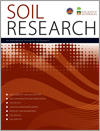SR21268Lessons from a landmark 1991 article on soil structure: distinct precedence of non-destructive assessment and benefits of fresh perspectives in soil research
 , María Balseiro-Romero, Nicolas Bottinelli
, María Balseiro-Romero, Nicolas Bottinelli  , María Briones, Yvan Capowiez, Patricia Garnier, Alexandra Kravchenko, Wilfred Otten, Valérie Pot, Steffen SchluÌter and Hans-Jörg Vogel
, María Briones, Yvan Capowiez, Patricia Garnier, Alexandra Kravchenko, Wilfred Otten, Valérie Pot, Steffen SchluÌter and Hans-Jörg Vogel
It took almost two decades for the paradigm shift advocated by Letey (1991) [Australian Journal of Soil Research 29(6), 699–707] for research on soil structure to gather momentum. In this article, we explain why that was the case, and why now this shift is crucial, at a time where we need to deal increasingly with issues related to soil functions. Letey’s (1991) article also encourages us to not be afraid of venturing into new fields and to ask probing questions about them.




